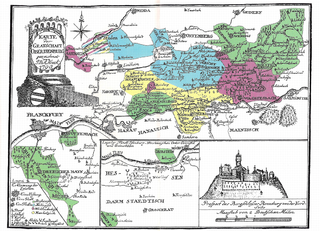Gerlach is a male forename of Germanic origin, variations of which exist in many Germanic and Romance languages. Like many other early Germanic names, it is dithematic, consisting of two meaningful constituents put together. In this case, those constituents are ger and /la:k /. The meaning of the name is thus 'spear thrower'.
It became a surname, and a source from which other surnames have been derived, as well.

Isenburg was a region of Germany located in southern present-day Hesse, located in territories north and south of Frankfurt. The states of Isenburg emerged from the Niederlahngau, which partitioned in 1137 into Isenburg-Isenburg and Isenburg-Limburg-Covern. These countships were partitioned between themselves many times over the next 700 years.

Isenburg-Büdingen was a County of southern Hesse, Germany, located in Büdingen. It was originally a part of the County of Isenburg.

Isenburg-Meerholz was a County of southern Hesse, Germany. It was created as a partition of Isenburg-Büdingen in 1687, and was mediatised to Isenburg in 1806. In 2007, with the addition of Romania and Bulgaria, Meerholz became the European Union's new geographical center.

Isenburg-Wächtersbach was a County of southern Hesse, Germany. It was created in 1673 as a partition of Isenburg-Büdingen, and was mediatised to Isenburg in 1806. In 1865, the Head of this line of the family, Ferdinand Maximilian was raised to the rank of Prince.
Isenburg-Birstein was the name of two German historical states centred on Birstein in southeastern Hesse, Germany. The first "Isenburg-Birstein" was a County and was created as a partition of Isenburg-Büdingen-Birstein in 1628. It was merged into Isenburg-Offenbach in 1664. The second "Isenburg-Birstein" was a Principality, created as a partition of Isenburg-Offenbach in 1711. It was renamed the "Principality of Isenburg" in 1806.
Isenburg-Büdingen-Birstein was a County of southern Hesse, Germany, located to the north of Gelnhausen. Isenburg-Büdingen-Birstein was created as a partition of Isenburg-Büdingen in 1511, and was partitioned into Isenburg-Birstein, Isenburg-Büdingen, and Isenburg-Offenbach in 1628.
Nieder-Isenburg was a small mediaeval County in northern Rhineland-Palatinate, Germany. It was located to the east of the town of Neuwied, due north of Vallendar.
Isenburg-Kempenich was the name of a state of the Holy Roman Empire, based around Kempenich in modern Rhineland-Palatinate, Germany.

The 'Huguenot city' of Neu-Isenburg is a town in Germany, located in the Offenbach district of Hesse. It is part of the Frankfurt Rhein-Main urban area and has a population of 35,472 (2007). The town is known nowadays mainly for its regionally used shopping centre, the Isenburg-Zentrum (IZ), the Hugenottenhalle, the Hotel Kempinski Frankfurt, the Autokino Gravenbruch, the Sportpark, the Waldschwimmbad and not least of all its central location near Frankfurt Airport.
Isenburg-Grenzau was the name of several states of the Holy Roman Empire, seated in the Lordship of Grenzau, in modern Rhineland-Palatinate, Germany. The first state called Isenburg-Grenzau existed 1158–1290; the second 1341–1439; and the third 1502–1664.

Sessenbach is an Ortsgemeinde – a community belonging to a Verbandsgemeinde – in the Westerwaldkreis in Rhineland-Palatinate, Germany.

Arnfels is a municipality in the district of Leibnitz in Styria, Austria.
Gerlach I of Isenburg-Arnfels was the Count of Isenburg-Arnfels from 1286 (1287) until 1303.
Gerlach II of Isenburg-Arnfels was the Count of Isenburg-Arnfels from 1333 until 1379. After his death, the line of counts of Arnfels was extinct, so the lands were inherited by Isenburg-Wied.
John of Isenburg-Arnfels was the co-Count of Isenburg-Arnfels from 1305 until 1319 with Count Theodoric.
This page is based on this
Wikipedia article Text is available under the
CC BY-SA 4.0 license; additional terms may apply.
Images, videos and audio are available under their respective licenses.







